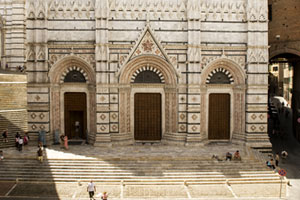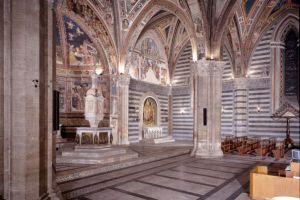Baptistery
Introduction
Saint Catherine was baptized in the Baptistery of San Giovanni, as were all the citizens of Siena for centuries. This place has an extraordinary importance, because through Baptism Christians become members of the universal Church and at the same time of their local community; thus besides being a symbol of rebirth in Christ, the baptismal font is also a sign of group identity. Compared to the usual structure of Baptisteries, the one in Siena has some distinctive characteristics. First and foremost is its position in back of the Cathedral rather than in front of it. Nonetheless, it manages in any case to fulfill its symbolic function of access to the Church, since it faces towards the vital heart of the city.
This Baptistery also lacks the traditional octagonal ground plan, a shape that expresses the participation of the baptized in Christ’s resurrection, which took place on the first day after the Sabbath, that is to say on the eighth day. The building is rectangular in shape, divided into a nave and two side aisles covered by cross vaults. The connotation of this space as a Baptistery is thus completely entrusted to two elements: the baptismal font, a magnificent synthesis of Tuscan sculpture of the fifteenth century, and the fresco decoration of the vaults illustrating the articles of the apostles’ Creed, which summarize the profession of faith required for admission . . .




